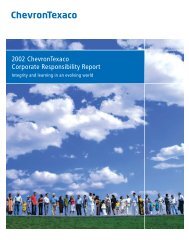Next* Magazine, Issue 5 - Chevron
Next* Magazine, Issue 5 - Chevron
Next* Magazine, Issue 5 - Chevron
Create successful ePaper yourself
Turn your PDF publications into a flip-book with our unique Google optimized e-Paper software.
PHOTO: RICHARD LORD<br />
catalysts, novel reactor-internals technology<br />
and innovative designs have delivered superior<br />
performance for <strong>Chevron</strong> and its licensees.<br />
<strong>Next*</strong>: How does hydroprocessing figure<br />
into future growth?<br />
Krishna: A couple of decades ago, all the<br />
finished lubricants on the market consisted<br />
of Group 1 base oils, which were relatively<br />
higher in sulfur, higher in aromatic content<br />
and less suitable for the higher-efficiency<br />
engines being developed. In the ’80s and<br />
’90s, we developed technology that uses<br />
hydroprocessing to make premium base<br />
oils, or Groups 2 and 3 oils, which modern<br />
vehicles’ more advanced engines need. As<br />
engines have become more efficient, the<br />
North America base oils market has shifted<br />
about 45 percent from Group 1 to Group 2<br />
and beyond. We use hydroprocessing technology<br />
in our Richmond, California, refinery<br />
and in the joint-venture GS Caltex refinery<br />
in Korea. When our Pascagoula, Mississippi,<br />
expansion project is completed, expected<br />
in 2013, <strong>Chevron</strong> is forecast to become the<br />
largest producer of premium base oil in<br />
the world.<br />
<strong>Next*</strong>: You mentioned that you also work<br />
with third-party technology companies.<br />
What role do they play in technology for<br />
Downstream & Chemicals?<br />
Krishna: We’ve had two joint ventures for<br />
a decade. One, <strong>Chevron</strong> Lummus Global<br />
LLC, licenses hydroprocessing technology<br />
around the world. In Advanced Refining<br />
Technologies, we are joint-venture partners<br />
with Grace Davison, a world-class catalyst<br />
manufacturing company that supplies most<br />
of <strong>Chevron</strong>’s hydrotreating catalyst needs.<br />
These two joint ventures conduct cuttingedge<br />
R&D in hydroprocessing technology,<br />
while the fundamental catalysis research is<br />
performed by <strong>Chevron</strong> Energy Technology Co.<br />
scientists.<br />
As an operator of units based on our own<br />
technology, <strong>Chevron</strong> also shares decades of<br />
experience in safe operations of high pressure<br />
hydroprocessing plants.<br />
<strong>Next*</strong>: What role does your group play in<br />
project development?<br />
Krishna: We collaborate with Downstream &<br />
Chemicals’ strategy and commercial integration<br />
groups to make sure that all the projects<br />
we develop make good business sense; we<br />
focus on the most creative technologies that<br />
we can implement.<br />
We also have a team of senior experts<br />
who contribute to Downstream & Chemicals’<br />
bottom line in two important ways: First,<br />
they make sure that the most innovative and<br />
cost-effective solutions and technologies<br />
are being applied in our capital projects,<br />
resulting in high capital efficiency. Second,<br />
our experts work with plant engineers and<br />
manufacturing process experts to squeeze<br />
additional value out of existing plants and<br />
operations.<br />
<strong>Next*</strong>: How do you make sure that<br />
<strong>Chevron</strong>’s products are top tier?<br />
Krishna: We have a fuels technology<br />
organization, with experts who understand<br />
fuel chemistry and performance. We are<br />
equipped with world-class analytical and performance<br />
testing facilities. This enables us<br />
to make sure that our Techron®-containing<br />
fuels are highest in performance.<br />
<strong>Next*</strong>: Is Downstream Technology<br />
integrated with Upstream in any way?<br />
Krishna: We are now building facilities at<br />
Upstream upgrader production sites that<br />
look more and more like refineries because<br />
the crudes are getting increasingly heavier<br />
and tougher to process. Rather than putting<br />
billions of dollars into building the refineries<br />
for processing those crudes, an option is for<br />
crudes to be upgraded at the production site.<br />
In Canada, the Athabasca Oil Sands<br />
Project uses our LC-FINING technology<br />
to upgrade bitumen from tar sands. In<br />
Venezuela, we’re looking at converting very<br />
heavy crude oil into a lighter, synthetic<br />
crude. In Nigeria, we are investing in the<br />
Escravos gas-to-liquids plant to convert gas<br />
into a waxy, difficult-to-transport liquid, and<br />
then use our ISOCRACKING technology to<br />
convert it into gasoline and diesel fuel.<br />
<strong>Next*</strong>: How do you see Downstream<br />
Technology’s role in the future?<br />
Krishna: We’ll remain focused on developing<br />
and deploying <strong>Chevron</strong> technology<br />
that enables superior performance. Our<br />
approach to technology is differentiating<br />
<strong>Chevron</strong> through lower costs, higher value,<br />
improved efficiency and better products<br />
for consumers. ■<br />
<strong>Next*</strong> | 27

















